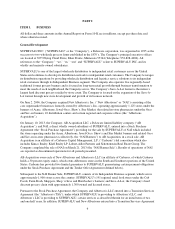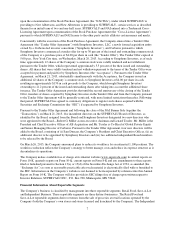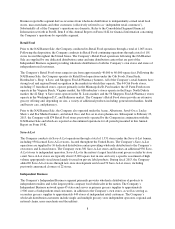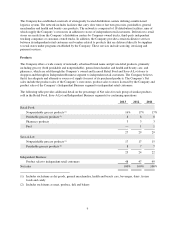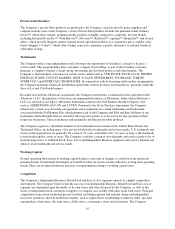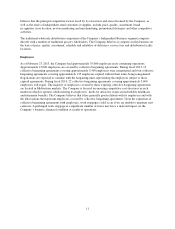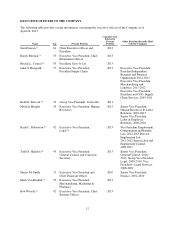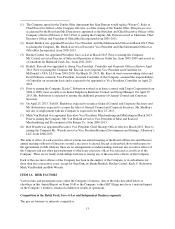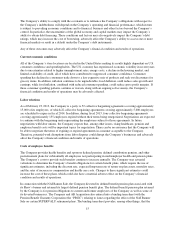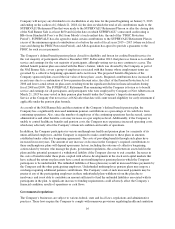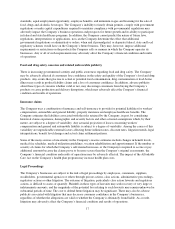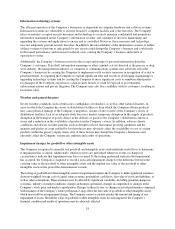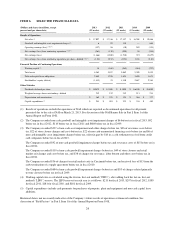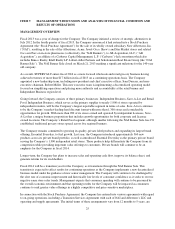Albertsons 2013 Annual Report Download - page 18
Download and view the complete annual report
Please find page 18 of the 2013 Albertsons annual report below. You can navigate through the pages in the report by either clicking on the pages listed below, or by using the keyword search tool below to find specific information within the annual report.Company will not pay any dividends to its stockholders at any time for the period beginning on January 9, 2013
and ending on the earliest of (i) March 21, 2018, (ii) the date on which the total of all contributions made to the
SUPERVALU Retirement Plan that were made to the SUPERVALU Retirement Plan on or after the closing date
of the NAI Banner Sale is at least $450 and (iii) the date on which SUPERVALU’s unsecured credit rating is
BB+ from Standard & Poor’s or Ba1 from Moody’s (such earliest date, the end of the “PBGC Protection
Period”). SUPERVALU has also agreed to make certain contributions to the SUPERVALU Retirement Plan in
excess of the minimum required contributions at or before the ends of fiscal years 2015—2017 (where such fiscal
years end during the PBGC Protection Period), and AB Acquisition has agreed to provide a guarantee to the
PBGC for such excess payments.
The Company’s defined benefit pension plan is closed for eligibility and frozen for credited benefit service for
the vast majority of participants effective December 2007. In December 2012, that plan was frozen as to credited
service and earnings for the vast majority of participants, although vesting service may continue to accrue. The
defined benefit pension plan associated with the Shaw’s banner, which was divested by the Company as part of
the NAI Banner Sale, covers a group of employees associated with that banner whose employment terms are
governed by a collective bargaining agreement and is not frozen. The projected benefit obligations of the
Company sponsored plans exceed the fair value of those plans’ assets. Required contributions have increased in
recent years due to a combination of lower pension discount rates, the effect of the Pension Protection Act of
2006 and lower actual return on plan assets resulting from the significant decline in financial markets during
fiscal 2008 and 2009. The SUPERVALU Retirement Plan remaining with the Company is frozen as to benefit
service and earnings for all participants, and participants who were employed by Company or New Albertsons on
March 21, 2013 became vested in their pension plan benefit under the Company’s largest retirement plan.
Service at the Company (but not service at NAI) after that date will count toward eligibility for early retirement if
applicable under the pension plan formula.
As a result of the NAI Banner Sale and the retention of the Company’s defined benefit pension plan, the
Company has a significantly increased minimum pension contributions as a percentage of its cash flows from
continuing operations. Also, since the number of employees of the continuing operations has decreased, certain
administrative and other benefits costs may increase on a per employee level. Additionally, if the Company is
unable to control healthcare benefits and pension costs, the Company may experience increased operating costs,
which may adversely affect the Company’s financial condition and results of operations.
In addition, the Company participates in various multiemployer health and pension plans for a majority of its
union-affiliated employees, and the Company is required to make contributions to these plans in amounts
established under collective bargaining agreements. The costs of providing benefits through such plans have
increased in recent years. The amount of any increase or decrease in the Company’s required contributions to
these multiemployer plans will depend upon many factors, including the outcome of collective bargaining,
actions taken by trustees who manage the plans, government regulations, the actual return on assets held in the
plans and the potential payment of a withdrawal liability if the Company chooses to exit a market. Increases in
the costs of benefits under these plans coupled with adverse developments in the stock and capital markets that
have reduced the return on plan assets have caused most multiemployer pension plans in which the Company
participates to be underfunded. The unfunded liabilities of these plans may result in increased future payments by
the Company and the other participating employers. Underfunded multiemployer pension plans may impose a
surcharge requiring additional pension contributions. The Company’s risk of such increased payments may be
greater if any of the participating employers in these underfunded plans withdraws from the plan due to
insolvency and is not able to contribute an amount sufficient to fund the unfunded liabilities associated with its
participants in the plan. A significant increase to funding requirements could adversely affect the Company’s
financial condition, results of operations or cash flows.
Governmental regulations
The Company’s businesses are subject to various federal, state and local laws, regulations and administrative
practices. These laws require the Company to comply with numerous provisions regulating health and sanitation
16


